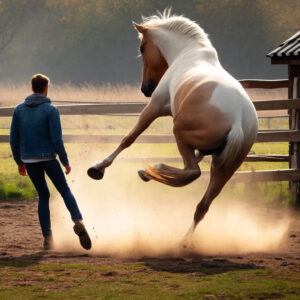
Understanding how horses tick isn’t just something nice to know; it’s the backbone of any training you’ll do.
Horses have their own way of seeing the world, and getting a grip on their psychology gives you a head start. It’s all about knowing why they act the way they do, and how that plays into their training.
Communication is key, right? Horses have this silent language through body movements, ears, and eyes. Knowing what those signals mean is crucial. Whether a flick of an ear or a swish of the tail, recognizing their language lets you respond better and build a stronger bond.
Spotting signs of stress or discomfort in your horse is a game-changer. If a horse suddenly seems jumpy or refuses to follow commands, they might be telling you something’s not quite right.
Watch for things like restlessness or pinning ears. Addressing these signs early keeps your training on track without souring the relationship.
Training is never a one-way street. It’s very much give-and-take, and respect goes both ways. A horse that trusts you will try harder, be calmer, and learn faster.
Creating an environment of mutual respect sets the stage for effective training sessions.
Essential Equipment for Beginner Horse Training

Getting set up with the right gear is a big part of starting off well in horse training. Having the essentials minimizes hiccups and makes your training smoother.
First up, getting the basic horse training gear is key. Halters, lead ropes, a sturdy saddle, and a good bridle are the starting lineup. Choose ones that fit your horse well to avoid discomfort or injury.
When it comes to picking the right equipment, it’s not just about style, but comfort and functionality. Saddles need to fit both you and your horse, so trying a few before buying could be a solid move.
Safety gear isn’t just helmets and boots. It includes gloves and reflective gear if you’re training in low light. Keeping safety top of mind helps prevent accidents before they happen.
Once you’ve got your gear, keeping it in top shape is super important. Regularly check for wear and tear. Clean them after use so they stay in good condition and last longer.
Step-by-Step Guide to Basic Horse Training Techniques

Starting with groundwork lays the foundation for everything else you’ll do with your horse. Simple exercises like leading and halting not only teach basic commands but also build trust.
Getting comfortable with commands like stop, go, and turn is a must. This creates a common language that makes future training smoother.
Lunging is another powerful tool. It helps horses learn to respect boundaries and respond to commands from a distance. Plus, it’s a great way to give your horse a workout without a saddle.
Once your groundwork is solid, it’s time to saddle up. Basic riding skills begin with understanding how your horse reacts to your weight, positioning, and command from up top.
Overcoming Common Challenges in Horse Training

Tackling common behavioral issues, like nipping or bucking, starts with understanding the why. Often, these actions pop up from discomfort or misunderstanding. Observing and adjusting your approach could resolve them without fuss.
Fear and anxiety aren’t just human problems; horses face them too. Helping your horse manage anxiety involves patience and creating a calm training environment. Sometimes a change of scenery or routine works wonders.
Let’s face it, training requires heaps of patience and consistency. Keep sessions short and sweet to maintain your horse’s interest and willingness. Building a routine helps both you and your horse stay focused.
Recognizing when it’s time to call in a pro is just smart. Strange or dangerous behaviors might need experienced eyes. Asking for help isn’t a step back; it’s a way to ensure safety and success.
